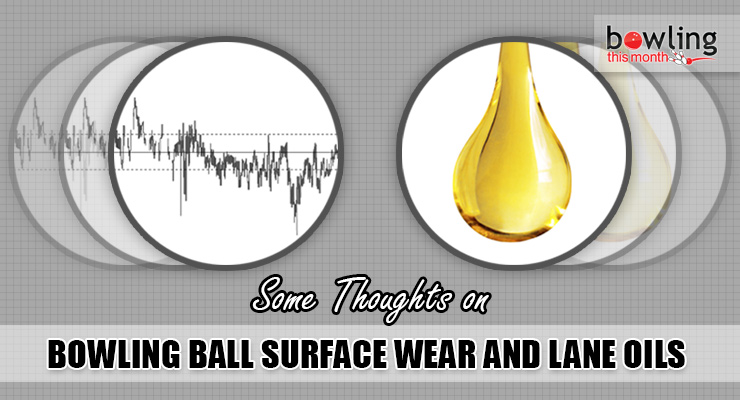Article Contents
- 1. Bowling ball surface wear
- 2. A new surface wear experiment
- 2.1. Experiment details
- 2.2. Results
- 2.3. Conclusions
- 3. Lane oil properties
- 3.1. Viscosity
- 3.2. Surface tension
- 3.3. Rheology
- 3.4. Relating science to reality
- 4. Last word
Note: This article is only available to Bowling This Month subscribers.
Understanding ball motion and lane transition are important factors in reaching your optimum scoring potential. Many things are occurring simultaneously that alter ball motion. Namely, the lane oil is depleting and the ball surface is changing, as I discussed in my previous article. This time, we’ll continue the discussion on bowling ball surface wear and then present some basic information on lane oil composition.
Whether you are bowling on a house shot or a more competitive sport condition, changes occur to the condition that affect scoring. Making educated guesses based on experience and knowledge are tantamount to staying at the top of the scoring pace. Susie Minshew wrote some time ago, “Whoever finds it first, wins.”
Before we delve into the subjects at hand, it is important that we first define the terminology:
- Ball motion: the amount of lateral change (hook), shape change (arc or hockey stick), and length (when) before change occurs.
- Lane transition: the alteration of ball motion during play due to environmental factors such as oil depletion, movement, temperature, humidity, etc.
What the bowler must understand are the changes in friction between the ball and the lane on its way to the pin deck. There are other factors, like lane surface composition, lane topography, lane age, competition level, etc. that affect transition and friction. Some of these topics have been covered in previous BTM articles and are beyond the scope of this article.
Bowling ball surface wear
In my previous article, Surface Management: What’s Your Number?, I described a method to measure bowling ball surface texture. Jayhawk Bowling Supply’s Ball Surface Scanner was used throughout that study. It attempted to highlight the following:
- Many league bowlers are not aware of the surface texture they are using and how difficult it is to determine the texture without proper analytical techniques.
- Surface texture changes during play:
- Highly textured surfaces degrade rapidly and should be resurfaced every three games to retain the identical surface texture and reaction.
- Smoother surfaces change less rapidly and require less maintenance.
- Developing or reproducing the desired surface texture using sanding pads and a ball spinner is difficult and requires practice plus trial and error.
- A measurement tool is essential. The laser surface scanner was indispensable to quantify and understand the surface adjustments during the experimentation.
One question, however, remained to be answered: does surface wear affect ball motion significantly during three games of competition?
Some great information related to this question is ...
Already a premium member? Click here to log in.


